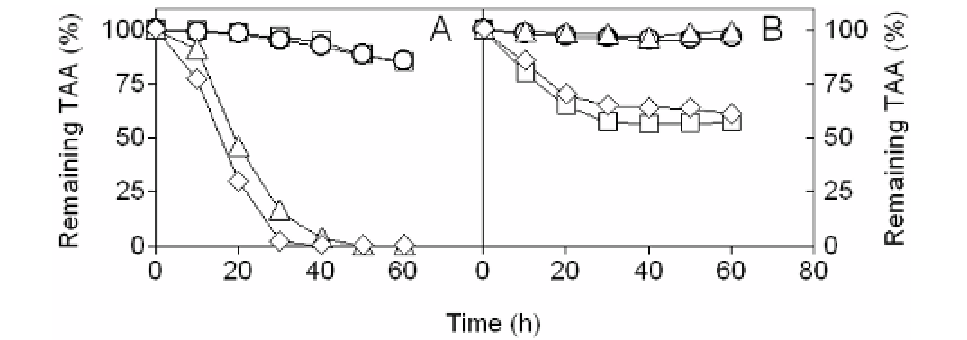Biomedical Engineering Reference
In-Depth Information
Figure 4. Stability of the total amylolytic activity (
TAA
) produced by
A. oryzae
FQB-01 in BW medium
in absence of substrate (starch). A: The amylase samples were buffered at pH 5.8 with 0.1 M potassium
hydrogen phthalate-HCl buffer and incubated at 40ºC (□), 50ºC (O), 60ºC (∆) and 70ºC (
◊
). B: The
enzyme preparation was buffered with 0.1 M potassium hydrogen phthalate-HCl buffer (at pH values of
4 (□), 5 (O) and 6 (∆)) and with 0.1 M sodium phosphate buffer (at pH value of 7 (
◊
)) and incubated at
46.4ºC.
In the same way, when amylase samples were adjusted at pH values of 4.0, 5.0, 6.0 and
7.0 and incubated at 46.4ºC for 1h in absence of starch, the highest stabilities were observed
at pH values of 5.0 and 6.0 (right part of Figure 4). In these cases, the enzyme retained 96 and
99% of its initial activity, respectively. In contrast, the enzyme lost about 42% and 39% of its
initial activity when it was incubated at pH values of 4.0 and 7.0, respectively (right part of
Figure 4).
Optimization of
TAA
Production in Solid State Fermentation (SSF)
Particle size, temperature, pH, initial moisture content of support material, inoculum size
and starch concentration are important factors that influence amylase production by
A. oryzae
strains in SSF (Gigras et al., 2002; Murado et al., 1997; Francis et al., 2003).
However, the effects of these variables on enzyme production depend on the strain and
the solid substrate or the support material used. For example, the use of a large particle size
(14 mm) support increased penicillin production by 37% in SSF using bagasse as an inert
support (Barrios-González et al., 1993). On the contrary, optimal particle size, moisture level
and inoculum concentration for
α
-amylase production in SSF by a strain of
Penicillium
chrysogenum
were >1 mm, 75% and 20% for corncob leaf, >1 mm, 65% and 20% for wheat
straw, 1 mm, 65% and 20% for wheat bran and >1 mm, 55% and 30% for rye straw (Balkan
& Ertan, 2007). However, an initial moisture content (70%), inoculum rate (1 × 10
7
spores/gds) and an incubation temperature in the range of 25-30ºC were necessary to achieved
the maximum
α
-amylase production by
A. oryzae
NRRL 6270 on spent brewing grains
(Francis et al., 2002). The optimal moisture level for glucoamylase production by
Aspergillus
sp. A3 in wheat bran was 80% (Ellaiah et al., 2002), while for
α
-amylase and glucoamylase
production by
A.
niger
LPB 28 (Spier et al., 2006) in cassava starch and sugar cane bagasse
was 90%.

